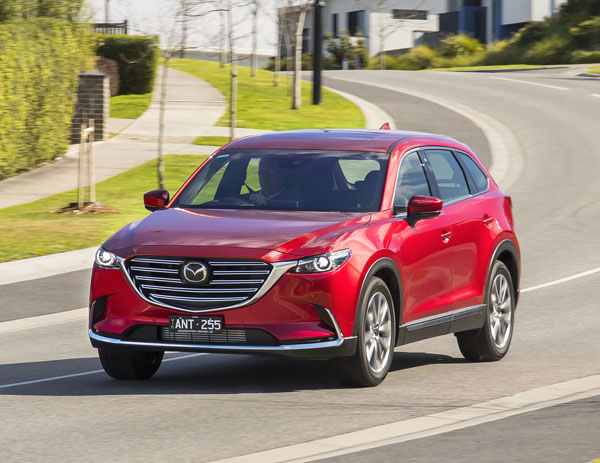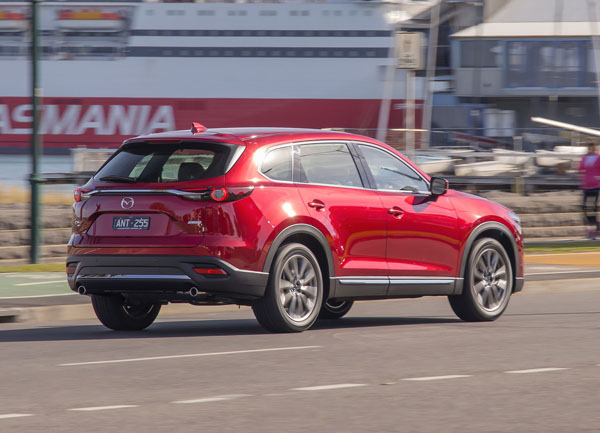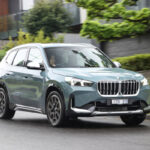 After a month of Mazdas, behind the wheel of everything from a Mazda2 mini to a big BT-50 pickup truck, it seemed appropriate to finish with a stint in a CX-9 Azami, the pinnacle of the company’s SUV product.
After a month of Mazdas, behind the wheel of everything from a Mazda2 mini to a big BT-50 pickup truck, it seemed appropriate to finish with a stint in a CX-9 Azami, the pinnacle of the company’s SUV product.
Since its Australian debut in 2016, the family-favourite sports utility vehicle has carried off a number of awards for its class-leading features. Now the bar has been raised higher.
The flagship SUV has been given dynamic, safety and comfort upgrades, including G-Vectoring Control to further improve handling.
Also improved are NVH levels, with a reduction in the height difference between the rear end of the roof moulding and the tailgate and increasing the thickness of the noise-absorbing material on the underside of the headliner.
In addition, noise-insulating material introduced on the back of the cargo area side trim reduces noise from the tyres and the rear of the vehicle. Inside the cabin, higher density floor mats better absorb sound and the insulation layer added to the ceiling liner reduces reverberation.
STYLING
It’s as you were as far as styling of the CX-9 is concerned, the only change being the addition of Soul Red Crystal Metallic, a newly developed body colour that has proven a big hit.
INTERIOR
Seating comfort has been further improved. The front pair of seats now have control over a wider range of positioning. All power seat function controls have gained a chrome-style finish. Heating has been added to the two outer seats in the middle row in GT and Azami models.
Automatic folding mirrors have been added across the range.
INFOTAINMENT
The CX-9 was the first Mazda to adopt a full-colour head-up active driving display projected onto the windscreen, giving key driving and navigation information just below the driver’s line of sight.
Mazda CX-9 now has the latest version of the MZD Connect system which links smartphones to the Internet and social media. In addition, the centre display on the dash has been enlarged to 8 inches on higher trim levels.
Mazda’s safety-oriented HMI (Human Machine Interface) functions as a touchscreen when the car is stationary and is controlled by the console-mounted knob when on the move.
ENGINES / TRANSMISSIONS
The vehicle is powered by the Skyactiv-G 2.5T, the newly-developed top-of-the-range petrol engine.
SAFETY
The Mazda CX-9 already came with a large range of safety features including blind spot monitoring, driver attention alert, rear parking sensors, rear cross traffic alert, reverse camera and smart city brake support (forward and reverse).
Now the i-Activsense safety technology includes pedestrian detection for smart city brake support (forward). While the speed range still begins at four km/h, the top speed has been significantly raised, from 30 km/h to 80 km/h.
Traffic sign recognition has been added to CX-9 GT and Azami models.
All models now get a second top tether point for third-row seats, enabling child or booster seats to be mounted to all three middle-row seats and both seats in the third row. There are also two IsoFix mounting points on both outer seats in the middle row.
DRIVING
The driver has come in for some extra attention with the seat adding a new power tilt function that adjusts the height of the cushion’s front edge. The setting, along with other positions, can be saved in the seat memory.
Passengers have improved operation of the second-row seats making it easier for those in the second and third rows to get in and out of the cabin.
The back of each second-row seat now leans 33 degrees forward when the seat is slid forward, increasing the distance between each seat and the rear-wheel housing from around 60 to 200 mm.
In addition, the angle of operation for the entry lever on the shoulder of each second-row seat is reduced from 58 degrees to 51 degrees, and the force needed to operate it is down by 25 per cent, while slide rail retainers for the second row are have been changed from metal to plastic, reducing slide resistance by almost a third.
Overall length of the new CX-9 is 5075 mm, which provides versatile storage for the gear needed by up to seven folk up front, but with this comes a wide turning circle of nearly 12 metres, so some thought needs to be put into parking spots.
With 420 Nm of torque on tap as low as 2000 rpm, the bulky CX-9, at almost two tonnes in weight, responds well to accelerator pedal inputs and literally eats up the kilometres when at cruising speeds.
Fuel economy is still not a feature of the upgraded maze CX-9, with the test vehicle recording 13.2 litres per 100 kilometres around town and 7.6 litres per 100 kilometres on the highway.
We are told the on-demand AWD system makes use of 27 sensors that check road conditions 200 times every second to give added grip where required. The ride is certainly consistent, adding a feel of confidence to the drive.
SUMMING UP
Upgrades to the CX-9 keep Mazda’s flagship SUV in touch with more expensive rivals in the prestige market, which can only be good news to fans of this friend of the family.
AT A GLANCE
MODEL RANGE
Mazda CX-9 Sport FWD $43,890
Mazda CX-9 Sport AWD $47,890
Mazda CX-9 Touring FWD $50,290
Mazda CX-9 Touring AWD $54,290
Mazda CX-9 GT FWD $58,790
Mazda CX-9 GT AWD $62,790
Mazda CX-9 Azami FWD $60,790
Mazda CX-9 Azami AWD $64,790
Note: These prices do not include government or dealer delivery charges. Contact your local Mazda dealer for drive-away prices.
SPECIFICATIONS (Mazda CX-9 Azami 2.5-litre turbo-petrol AWD five-door wagon)
ENGINE:
Capacity: 2.488 litres
Configuration: Four cylinders in line
Maximum Power: 170 kW @ 5000 rpm
Maximum Torque: 420 Nm @ 2000 rpm
Fuel Type: Petrol 91RON
Combined Fuel Cycle (ADR 81/02): 8.8 L/100km
CO2 Emissions: 206 g / km
DRIVELINE: Six-speed SkyActiv-Drive automatic, AWD
DIMENSIONS, WEIGHT AND CAPACITIES:
Length: 5075 mm
Wheelbase: 2930 mm
Width: 1969 mm
Height: 1747 mm
Turning Circle: 11.8 metres
Kerb Mass: 1924 kg
Fuel Tank Capacity: 74 litres
BRAKES:
Front: Ventilated disc
Rear: Solid disc
STANDARD WARRANTY:
Three years / unlimited kilometres











